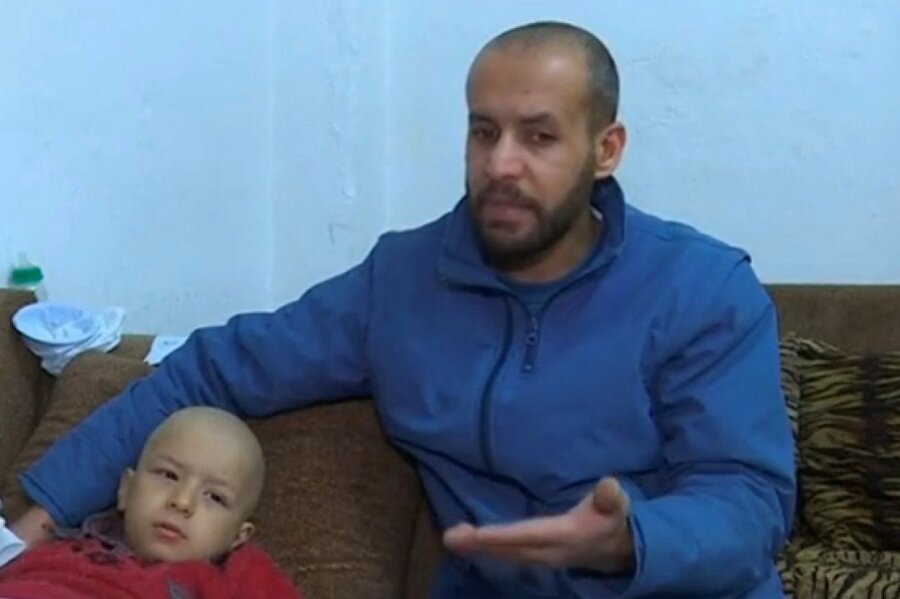World's most vulnerable refugees struggle as US welcome mat shrinks
Loading...
| Zarqa, Jordan
Their bags were packed. They began selling their furniture last week to pay outstanding debts. With US security clearance and health tests completed, Ied Hamid, his wife, and five children were awaiting their tickets to Dallas when they heard the news. President Trump had suspended Syrian resettlement to the US indefinitely.
Now, the Syrian refugee family is back where it started two years ago, eking out an existence in Jordan while looking for Western specialists to treat their son Abdullah, who was badly injured in a 2013 missile strike in Homs, Syria.
“We were not coming for jobs, we were coming to reclaim my son’s life,” says Mr. Hamid, sitting in the family's sparse concrete apartment in Zarqa, an industrial city north of Amman.
The Hamids are part of a US refugee resettlement program that for decades has accepted some of the world’s most vulnerable people. They include those needing medical assistance, victims of torture and trafficking or domestic abuse, single women, LGBT people, and those who converted to another religion that is not accepted in their homeland or in their host community. The world’s largest single refugee resettlement program, the US Refugee Admissions Program (USRAP) admitted 85,000 refugees to the US in fiscal year 2016, including 12,587 Syrians and 9,880 from Iraq.
Now with USRAP suspended for 120 days (and for Syrian refugees, suspended indefinitely) and the Trump administration's aim to halve the number of refugees that President Obama had targeted for 2017, vulnerable refugees across the region are struggling for alternatives.
Nowhere is the problem more acute than in Jordan, the largest transit country for Middle East refugees destined for the US, and the place where the US does most of its resettlement process.
Tennessee-bound, then...
The ban was a blow for Haleema Ibrahim, who along with her husband and seven children has spent three years in Amman since arriving from Darfur, Sudan, awaiting resettlement to the US. The US is the only country taking Sudanese refugees from the Middle East, according to officials from relief agencies and the UN. On average, the US takes thousands of Sudanese worldwide and between 100 to 200 Sudanese refugees from the 3,000-strong community in Jordan each year.
Ms. Ibrahim’s family thought that years of hardship would soon be over after they secured their final clearance, set to start a new life in Tennessee this month.
With the US closing its doors, at least for 120 days, they have few alternatives.
“We do not know what to do,” says Ibrahim. “We are at the mercy of God – and the US president.”
Under the USRAP, the majority of accepted refugees are vetted and forwarded by the UN High Commissioner for Refugees (UNHCR). The USRAP also considers applications from Iraqi and Afghani citizens who worked alongside the US armed forces and various contractors and, due to their US affiliation, face violent reprisals.
The ban has been a “crisis” for Mohammed, a 28-year-old Iraqi, who declined to use his real name.
Mohammed is LGBT, a sexual orientation that is stigmatized in much of the Middle East, and in some areas that puts him at risk of violence. Mohammed says he is no longer able to return to Baghdad for fear of “death,” and fears persecution in Jordan.
Due to his sexual orientation and vulnerability, Mohammed was accepted into the USRAP program and was hoping for resettlement this year.
“The US I knew stood for LGBT rights and human rights,” he says. “Now the US does not want me because of my nationality, religion, and sexual preference. There is nowhere left for me to go.”
Struggle in Jordan
Staying put is not a long-term solution, either, refugees and experts agree. In 2016, according to UNHCR, 19,800 refugees were resettled to other countries, mainly the US, from Jordan. But this desert nation of 6.5 million citizens is hosting 1.3 million Syrians. This is in addition to tens of thousands of Iraqi, Sudanese, and Somali refugees. The sudden influxes into the resource-poor nation have caused rents and food prices to soar.
“One of the problems facing refugees that are now stranded in the Middle East is that due to the impact of the conflicts, it is more and more difficult to survive,” says Eleanor Acer, director of the refugee protection program at Human Rights First, a US-based human rights advocacy group. “These countries have been struggling to host refugees for some time, they have imposed restrictions which have made life difficult.”
In Jordan, Sudanese are not allowed to work, while only a very select number of Syrians and Iraqis are granted work permits.
Hamid relies on his son, Mohammed Nour, who picks up odd jobs as an electrician and a plumber, to put food on the table. If he were caught working, he would be deported and the family would lose its main bread-winner. The family’s $211 in monthly UN assistance goes to pay rent and electricity.
Ibrahim’s husband takes odd jobs washing cars in affluent West Amman in order to pay for $280 monthly rent in a run-down apartment in working-class East Amman. The family lives off lentils, and often relies on meals handed out by their Jordanian neighbors to give their children a taste of chicken every few weeks.
Many refugees fear further delays, while others – after noting the mood from America and Trump’s rhetoric – are questioning whether they want to go to the US at all.
“We want to be treated as human beings, not as terrorists,” says Hamid.
But for others, all they can do is wait, hoping that pressure from US citizens will force the Trump administration to reconsider the ban.
“All we can do is pray for God’s help in these four months,” Ms. Ibrahim says.







